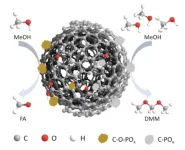(Press-News.org) Ancient DNA from bones and teeth hints at a role of the plague in Stone Age population collapse. Contrary to previous beliefs, the plague may have diminished Europe's populations long before the major plague outbreaks of the Middle Ages, new research shows.
In the 14th century Europe, the plague ravaged the population during the so-called 'Black Death,' claiming the lives of nearly a third of the population.
But the plague arrived in Scandinavia several thousand years earlier, and despite several theories suggesting otherwise, the plague might have caused an epidemic, according to new research from the University of Copenhagen.
In collaboration with researchers from the University of Gothenburg in Sweden, researchers from the Globe Institute, have analyzed DNA from ancient teeth and bones of 108 individuals who died 5,000 years ago.
"The analyses show that 18 of these individuals, 17 percent, were infected with the plague when they died. Furthermore, our results suggests that the youngest plague strain we identify might have had epidemic potential," says postdoc Frederik Seersholm, who led the DNA analysis.
This means that the plague at that time may have been a contributing factor to the population collapse in the end of the Neolithic, known as the Neolithic decline. This population bust caused large parts of the farming population in Scandinavia and Northwestern Europe to disappear within just a few centuries, 5000 years ago.
"We cannot – yet – prove that this was exactly how it happened. But the fact that we can now show that it could have happened this way is significant. The cause of this population decline, which we have known about for a long time, has always been subject of debate," says Frederik Seersholm.
The archaeological material analysed comes mainly from passage graves in Sweden, but one of the individuals is from a stone cist in Stevns, Denmark.
Ancient DNA provides answers
The analyses were conducted using a method called "deep shotgun sequencing," which allows researchers to extract highly detailed information from archaeological material, even though ancient DNA is often heavily damaged or degraded. The researchers examined DNA from tooth and bone material from the Neolithic time period, studying both familial relations and diseases in the individuals.
“We have been able to carry out a comprehensive mapping of plague lineages, and a detailed description of other microbes in the DNA data. At the same time, through these analyses, we have been able to look at the human DNA from a broad perspective to a local one – and right down to the individual level, getting a picture of the social organization that existed back then,” says Associate Professor Martin Sikora at the Globe Institute, who is also behind the study.
The finding that 17 percent of the individuals whose DNA was analyzed had plague, indicates that the plague was common in Scandinavia during the late Stone Age.
In one of the analyzed families, at least three plague outbreaks was observed over the six generations in the family that researchers have been able to map.
“The question of possible kinship relations between individuals whose bones and teeth have been found in megalithic tombs has been debated for at least 200 years. There have been many theories and speculations, but now, thanks to DNA, we have data,” says Karl-Göran Sjögren, Associate Professor of Archaeology at the University of Gothenburg, who was also involved in the new study.
Frederik Seersholm believes that the new results rules out previous theories suggesting that the population decline could not have been caused by plague.
“In connection with the population decline in the end of the Neolithic, both war and outbreaks of infectious diseases, including plague, have been suggested. There have been several theories involving the plague, and one of them suggested that the plague could not have caused an epidemic – but that assumption no longer holds,” says Frederik Seersholm.
END
The plague may have caused the downfall of the Stone Age farmers
2024-07-10
ELSE PRESS RELEASES FROM THIS DATE:
When there’s money to lose, phone usage while driving drops
2024-07-10
PHILADELPHIA— To make someone put their phone down while driving, show them the money—with a catch, according to new research published in JAMA Open. When a group of auto insurance customers were tempted with a cash incentive—and regular feedback letting the driver know how they were doing compared to other drivers trying to reduce their phone time—handheld phone use dropped significantly, a team at the Perelman School of Medicine at the University of Pennsylvania found.
The researchers examined several different strategies ...
Astronomers find missing link in massive black hole formation
2024-07-10
Omega Centauri is a spectacular collection of 10 million stars, visible as a smudge in the night sky from Southern latitudes. Through a small telescope, it looks no different from other so-called globular clusters; a spherical stellar collection so dense towards the center that it becomes impossible to distinguish individual stars. But a new study, led by researchers from the University of Utah and the Max Planck Institute for Astronomy, confirms what astronomers had argued about for over a decade: Omega Centauri contains a central black hole. The black hole appears to be the missing link between its stellar ...
Researchers build first-ever molecular atlas of blood vessel pathways in the human brain, across early brain development, adulthood and disease
2024-07-10
An international consortium of researchers led by University Health Network (UHN) in Toronto and University of Zurich have built the first-ever molecular atlas of the human brain vasculature at single-cell resolution, spanning from early development to adulthood and through disease stages such as brain tumours and brain vascular malformations.
The international consortium includes research teams from UHN’s Krembil Brain Institute, Donald K. Johnson Eye Institute, Toronto General Hospital Research Institute and Princess Margaret Cancer Centre, the University of Toronto’s Donnelly Centre, Mount Sinai Hospital’s Lunenfeld-Tanenbaum ...
Antiferromagnetic phase transition observed in fermionic Hubbard quantum simulator
2024-07-10
In a study published online in Nature, a research team led by Prof. PAN Jianwei, Prof. CHEN Yuao, and Prof. YAO Xingcan from the University of Science and Technology of China (USTC) of the Chinese Academy of Sciences has, for the first time, observed the antiferromagnetic phase transition within a large-scale quantum simulator of the fermionic Hubbard model (FHM). This study highlights the advantages of quantum simulation. It marks an important first step towards obtaining the low-temperature phase diagram of the FHM and understanding the role of quantum magnetism in the mechanism of high-temperature ...
A drug that lowers blood lipids could help treat the world’s most common liver disease
2024-07-10
The University of Barcelona has led a study that suggests using the drug known as pemafibrate to treat liver disease associated with metabolic disorders, the most common liver pathology in the world, which affects one in four people. The drug has long been marketed in Japan for another use: improving blood lipid levels in patients with hyperlipidaemia, a common condition in diabetics. Now, however, it could help address this serious liver disease, which still has no specific treatment.
The study, carried out on laboratory animal models and published in the journal Biomedicine & Pharmacotherapy, was conducted by a team led by Professor Juan ...
Ochsner, AJMC® partner for conference on value-based care on July 25 in New Orleans
2024-07-10
NEW ORLEANS – Ochsner Health’s Healthy State initiative, in partnership with The American Journal of Managed Care, will host a free conference on value-based care from 3:30-7 p.m. on Thursday, July 25 at The Westin New Orleans hotel in Louisiana.
Registration and program details are available here for “Healthy State: Know It, Own It, Live It: Creating a Thriving Louisiana Through Innovation in Value-Based Care.” The event is open to the public, medical professionals, health policy experts and community organizers.
Organized ...
NIH funds consortium to accelerate development of new TB treatments
2024-07-10
A new consortium co-led by Weill Cornell Medicine, has been awarded a five-year, $31 million grant from the National Institutes of Health’s National Institute of Allergy and Infectious Diseases to accelerate the development of faster, more effective treatment regimens for tuberculosis (TB). Investigators at the University of California, San Francisco; Johns Hopkins Medicine; and Vanderbilt University Medical Center comprise the other co-leads.
The Preclinical Design and Clinical Translation ...
Older women more likely to receive heart surgery, die at low quality hospitals
2024-07-10
Women over the age of 65 who require complex heart surgery are more likely than men to receive care at low quality hospitals — where they also die in greater numbers following the procedure, a Michigan Medicine study finds.
The research, published in JAMA Network Open, covered nearly 450,000 Medicare beneficiaries who underwent coronary artery bypass grafting, or heart bypass surgery, between late 2015 and early 2020.
Compared to men, women were 1.26 times more likely to be treated at low quality hospitals, meaning facilities with the highest 30-day mortality rates.
At those low quality hospitals, ...
Nanocarbon catalyst design unlocks new avenue for sustainable fuel additive production
2024-07-10
Vehicle exhaust from fossil fuel combustion constitutes a main source of air pollutants like carbon dioxide and carbon monoxide. To mitigate air pollution, researchers are looking into additive to fuels like dimethoxymethane (DMM). But DMM production brings its own environmental hazards.
In their paper published June 21 in Carbon Future, a Chinese research team demonstrated how a series of phosphorous-modified nanocarbon catalysts could advance green DMM production.
Unique fuel properties of this diesel blend fuel include high oxygen content and chemical stability as well as low toxicity. A blend of DMM and ...
Wolves’ return has had only small impact on deer populations in NE Washington, study shows
2024-07-10
FROM: James Urton
(Note: researcher contact information at the end)
Humans drove wolves to extinction in Washington state around the 1930s. Thanks to conservation efforts, by about 80 years later, wolves had returned — crossing first from the Canadian border into Washington around 2008 and later entering the state from Idaho. Since then, wolf numbers in Washington have been steadily growing, raising questions about what the return of this large predator species means for ecosystems and people alike.
In northeast Washington, where wolves have recovered most successfully, researchers from the University of Washington and the Washington Department ...




